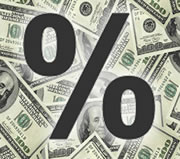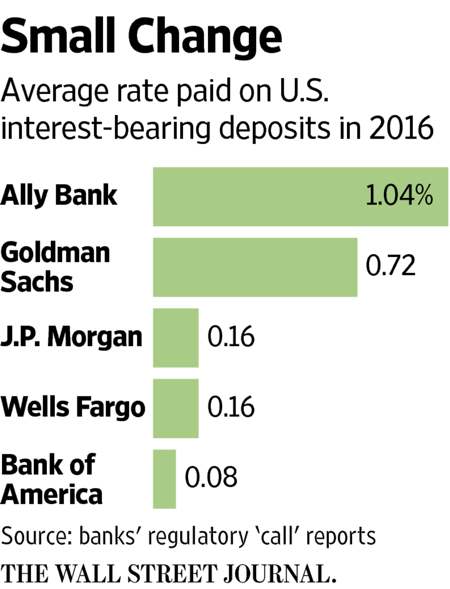
The WSJ article Bank of America Pays Peanuts for Deposits, but the Money Keeps Flowing In (paywall) outlines how BofA gets away with paying less interest on its deposits than nearly any other US bank (not that the other mega-banks are that much better). BofA only pays an average of 0.08% on $796 billion of cash deposits, including certificates of deposit:

Keep your savings somewhere else! Even if you have a BofA account for the ATM network, you can avoid fees on their basic checking accounts with either a monthly direct deposit, a minimum balance of $1,500 with no direct deposit, or by keeping $20,000 in stocks/ETFs at Merrill Edge with no direct deposit and no minimum balance. Anything above that can easily earn more interest with a companion account like Ally Bank Savings that now has 1-day transfers between linked accounts.
On that note, here is my monthly roundup of the best safe rates available, roughly sorted from shortest to longest maturities. Rates checked as of 5/11/17.
High-yield savings accounts
While the huge brick-and-mortar banks rarely offer good yields, the online banks with a history of competitive rates offer online savings accounts clustered around 1% APY. An important feature to note with savings account is that their interest rates can change at any time.
- As I’ve been “bait-and-switched” a few times and there are no lucrative rates that make it worth taking another risk, I am currently sticking with Ally Bank for their reliably competitive rates and overall good user experience. Their online savings is currently at 1.05% APY.
Money market mutual funds
If you like to keep cash in a brokerage account, you should know that money market and short-term Treasury rates have been inching upwards. It may be worth the effort to move your money into a higher-yielding money market fund.
- The Vanguard Prime Money Market Fund has increased their SEC yield to a half-decent 0.95%. The default sweep option is the Vanguard Federal Money Market Fund, which only has an SEC yield of 0.69%. You can manually move the money over to Prime if you meet the $3,000 minimum investment.
Short-term guaranteed rates (under 1 year)
I am often asked what to do with a big wad of cash that you’re waiting to deploy shortly (just sold your house, just sold your business, inheritance). Honestly, I wouldn’t get fancy or take unnecessary risk. Just keep it safe in a short-term CD or online savings account that in insured under the FDIC limits until you have a plan.
- Palladian Private Bank has a 6-month promotional rate of 1.30% APY guaranteed (maximum initial deposit of $100k) for new accounts. After the first 6 months, the rate reverts back to their normal rate (currently 0.90% APY). Since the initial promo rate is fixed, this makes it the highest guaranteed 6-month CD rate available.
US Savings Bonds
Series I Savings Bonds offer rates that are linked to inflation and backed by the US government. You must hold them for at least a year. There are annual purchase limits. If you redeem them within 5 years there is a penalty of the last 3 months of interest.
- “I Bonds” bought through the end of April 2017 now will earn a 1.96% rate for the first six months, and then a variable rate based on ongoing inflation after that. While that next 6-month rate is currently unknown, at the very minimum the total yield after 12 months will around 1% with additional upside potential. More info here.
- In mid-October, the CPI will be announced and you will have a short period where you will have a very close estimate of the rate for the next 12 months. I will have another post up at that time.
Prepaid Cards with Attached Savings Accounts
A small subset of prepaid debit cards have an “attached” FDIC-insured savings account with high interest rates. The risks are that balances are capped, and there are many fees that you must be careful to avoid (lest they eat up your interest). The other catch is that these good features may be killed off without much notice. My NetSpend card now only has an eligible balance up to $1,000.
- Insight Card is one of the best remaining cards with 5% APY on up to $5,000 as of this writing. Fees to avoid include the $1 per purchase fee, $2.50 for each ATM withdrawal, and the $3.95 inactivity fee if there is no activity within 90 days. If you can navigate it carefully (basically only use ACH transfers and keep up your activity regularly) you can still end up with more interest than other options.
Rewards checking accounts
These unique checking accounts pay above-average interest rates, but with some risk. You have to jump through certain hoops, and if you make a mistake you won’t earn any interest for that month. Rates can also drop quickly, leaving a “bait-and-switch” feeling. But the rates can be high while they last.
- Consumers Credit Union offers up to 4.59% APY on up to a $20k balance, although 3.09% APY on a $10k balance might be easier to achieve unless you satisfy a long list of requirements. Note that the 4.59% APY requires you to apply and get approved for an additional credit card through them (other credit cards offer $500+ in sign-up bonuses). Keep your 12 debit purchases small as well, as for every $500 in monthly purchases you may be losing out on 2% cashback (or $10 a month on after-tax benefit). Find a local rewards checking account at DepositAccounts.
Certificates of deposit
If you have a large cushion, it’s quite likely to just sit there for years. One option is to keep your money in longer-term investments where you can still take it out in a true emergency and pay a reasonable early withdrawal penalty. Alternatively, you could create a CD ladder of different maturity lengths such that you have access to part of the ladder each year, but your blended interest rate is higher than a savings account.
- Connexus Credit Union is offering a 1-year Share Certificate at 1.50% APY (90-day early withdrawal penalty) and a 3-year Share Certificate (180-day early withdrawal penalty) at 2.00% APY. Both have a $5,000 minimum deposit. Anyone can join this credit union via partner organization Connexus Association for a one-time $5 fee.
- Hanscom Federal Credit Union is offering a 4-year Share Certificate at 2.50% APY (180-day early withdrawal penalty) if you also have Premier Checking (no monthly fee if you keep $6,000 in total balances or $2,000 in checking). HFCU also offer a 3% APY CU Thrive “starter” savings account. HFCU membership is open to active/retired military or anyone who makes a one-time $35 donation to the Nashua River Watershed Association.
Longer-term Instruments
I’d use these with caution, but I still track them to see the rest of the current yield curve.
- Willing to lock up your money for 10+ years? Did you know that you can buy certificates of deposit via Vanguard’s bond desk? These “brokered CDs” still offer the same FDIC-insurance. As of this writing, you can get a 10-year non-callable CD that pays 2.75% APY. (Unfortunately, current long-term CD rates do not rise much higher even as you extend beyond a 5-year maturity.) Prices will vary daily.
- How about two decades!? Series EE Savings Bonds are not indexed to inflation, but they have a guarantee that the value will double in value in 20 years, which equals a guaranteed return of 3.5% a year. However, if you don’t hold for that long, you’ll be stuck with the normal rate which is quite low (currently a sad 0.10% rate). You could view as a huge early withdrawal penalty. You could also view it as long-term bond and thus a hedge against deflation, but only if you can hold on for 20 years. Too long for me.
All rates were checked as of 5/11/17.
 The Best Credit Card Bonus Offers – 2025
The Best Credit Card Bonus Offers – 2025 Big List of Free Stocks from Brokerage Apps
Big List of Free Stocks from Brokerage Apps Best Interest Rates on Cash - 2025
Best Interest Rates on Cash - 2025 Free Credit Scores x 3 + Free Credit Monitoring
Free Credit Scores x 3 + Free Credit Monitoring Best No Fee 0% APR Balance Transfer Offers
Best No Fee 0% APR Balance Transfer Offers Little-Known Cellular Data Plans That Can Save Big Money
Little-Known Cellular Data Plans That Can Save Big Money How To Haggle Your Cable or Direct TV Bill
How To Haggle Your Cable or Direct TV Bill Big List of Free Consumer Data Reports (Credit, Rent, Work)
Big List of Free Consumer Data Reports (Credit, Rent, Work)
I like All America Bank. Their mega money market account pays 1.25% on balances up to $35,000. Their ACH transfers take only 1 day. https://allamerica.bank/gallery/mega-money-market-checking/
Have you looked at the Summit Checking Account from Aspiration? They offer a 1% savings rate on their checking account for greater than 2.5K balances. Curious to hear your thoughts
I’ve looked briefly at the Summit Checking. It seems good and I don’t see any real catches, although it doesn’t really stand out from other banks or credit unions with 1% APY options like Ally and Alliant Credit Union. But if you are moving from Chase/BofA/Wells Fargo, anything with 1% will be a significant improvement.
Thanks for the summary good recap.
I was looking to buy a savings bond for my nephew who is 3. Is the EE A GOOD idea still or is there something better? And if I am buying USA bonds is the only place to get them treasury direct? Have they improved their protections at all, since they are not a fdic bank?
It seems like a lot of these accounts have maximum limits, any suggestions on where to keep around 100k for around 3-5 years?
There is no limit on the Ally 1.05% rate, but FDIC insurance will only cover you up to $250k for an individual and $500k for a joint account.
Thanks Thats where I currently have it in ally. What about savings bonds you have any experience there?
For a 3-year-old, I find savings bonds less fun now because there is no longer a paper option. Does he have a 529 college savings account you could contribute to instead? That way it is tax-deferred for the next 15 years when used for tuition or room/board.
If the Vanguard Prime Money Market Fund has an SEC yield of .95% but an expense ratio of .16%, is the yield actually .79%?
No, the SEC yield is net of expenses. You’ll get 0.95%, although the rate will keep varying.
This is offering 1.3% on Savings.
https://www.bankpurely.com/
Note that in order to earn the best rate at Consumers CU you not only have to get their credit card but also spend $1000/mo on it (in addition to the required debit transactions).
Don’t forget MUFG’s new online savings Pure Point. 1.25% for greater than 10k balances.
Great blog Jonathan! Dollars Savings Direct is now offering 1.25% high yield savings account. Great to see them offering competitive rates once again: https://www.dollarsavingsdirect.com/DollarSavingsDirectWeb/index.jsp
Wells is .16% in 2016? Where? I’m getting .06% in their PMA high yield savings.
That number is weighted across all of their interest-paying deposits including certificates of deposit.
@Jonathan – thanks for this summary. I have the combination of Ally (1.05%) + Vanguard money market (0.95%) too.
The good news is that the rates overall are trending up, so even without rate chasing there is potential tp get more interest in existing accounts as well.
p.s – Your site is now making me do math for captcha before posting comments 😉